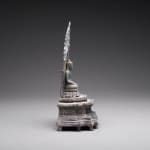Khmer Tripartite Sculpture of the Buddha, 12th Century CE - 13th Century CE
Bronze
height 20.3 cm
height 8 in
height 8 in
FZ.424
Further images
The Khmer civilization, today embodied by the temples and ruins of Angkor, one of mankind's most astonishing and enduring architectural achievements, flourished from 802-1431 A.D. From the great citadel of...
The Khmer civilization, today embodied by the temples and ruins of Angkor, one of mankind's most astonishing and enduring architectural achievements, flourished from 802-1431 A.D. From the great citadel of Angkor, the kings of the Khmer empire ruled over a vast domain that reached from what is now southern Vietnam to Yunan, China and from Vietnam westward to the Bay of Bengal. The original city was built around the Phnom Bakeng, a temple on a hill symbolizing the mountain that stands in the center of the world according to Hindu cosmology. Successive kings enlarged the city, building other temples devoted to various Hindu deities and large reservoirs used for irrigation, which also symbolized the ocean surrounding the holy central mountain.
The Bayon style of Khmer art flourished under the rule of a wise and powerful monarch, Jayavarman VII. The sculpture became more lifelike, reflecting more of a human ideal of beauty than the monumental art of the previous Brahmanic periods. Bayon works combined a tempered realism with an intense expressiveness. The famous “Angkor smile,” as epitomized by this bronze Buddha, dates to this period. The Bayon period was characterized by its allegiance to the Sakyamuni, a temporary religious trend that would only last until the resurgence of Brahmanic sects shortly after the passing of Jayavarman VII.
This sculpture is composed of three individual pieces that fit securely together to form the whole work: the tiered throne, the seated Buddha, and the , or body aureole, complete with a floral frame and interior halo. The Buddha rests upon a lotus seat, or , a symbol of his divine birth and total purity, posing in the Bhumisparsa mudra, or “gesture of touching the earth.” This portrays the Buddha taking the earth as witness; it is a gesture of unshakable faith and resolution. More than a gorgeous work of art, this sculpture is a memorial to one of the most flourishing creative periods in the great history of Angkor.
The Bayon style of Khmer art flourished under the rule of a wise and powerful monarch, Jayavarman VII. The sculpture became more lifelike, reflecting more of a human ideal of beauty than the monumental art of the previous Brahmanic periods. Bayon works combined a tempered realism with an intense expressiveness. The famous “Angkor smile,” as epitomized by this bronze Buddha, dates to this period. The Bayon period was characterized by its allegiance to the Sakyamuni, a temporary religious trend that would only last until the resurgence of Brahmanic sects shortly after the passing of Jayavarman VII.
This sculpture is composed of three individual pieces that fit securely together to form the whole work: the tiered throne, the seated Buddha, and the , or body aureole, complete with a floral frame and interior halo. The Buddha rests upon a lotus seat, or , a symbol of his divine birth and total purity, posing in the Bhumisparsa mudra, or “gesture of touching the earth.” This portrays the Buddha taking the earth as witness; it is a gesture of unshakable faith and resolution. More than a gorgeous work of art, this sculpture is a memorial to one of the most flourishing creative periods in the great history of Angkor.







